
The Second Presbyterian Church is the fourth oldest church in Charleston, South Carolina.

The Second Presbyterian Church is the fourth oldest church in Charleston, South Carolina.
Fifteen men began planning for Second Presbyterian Church in 1809. The Reverend Andrew Flinn organized the congregation to accommodate the growing congregation at First (Scots) Presbyterian Church on lower Meeting Street. The new church was built at 342 Meeting St., Charleston, South Carolina at the then substantial cost of $100,000, and on April 3, 1811, it was dedicated as "The Second Presbyterian Church of Charleston and Its Suburbs." The land had been obtained from the Wragg family. [1] An act of the state legislature authorized the holding of a public lottery to raise funds for the building. [2]
Thomas Smyth served as minister for more than forty years in the nineteenth century, from 1832 until his death in 1873. [3]


The church, built in the Jeffersonian style is the fourth oldest church structure in the city. The brothers James and John Gordon were both the builders and the architects. The church's steeple was not completed due to structural issues that developed in its tower. [4] The church bell was given to the Confederacy in 1862 for use as cannon metal. Before the Civil War, the galleries were used by the church's more than 200 black members. The sanctuary was completely renovated after a fire in 1959. Situated on one of the highest points in the city, the church appeared on mariners' maps as "Flynn's Church," so called after the first pastor. [5]
The Classic Revival sanctuary is stuccoed brick with two tiers of windows, a square tower with an octagonal belfry, and a tetra Tuscan portico. The size of the sanctuary presented a problem because it strained the voices of the ministers. Therefore, in 1833 the floor was raised three feet, the ceiling lowered sixteen feet, and the rear wall of the nave moved to enlarge the vestibule. In addition, side doors on the north and south were closed and pews were added. The pews used today were installed in 1849. Church pews were rented with the rental fee also purchasing a space in the cemetery plot. This custom ended in 1924, but the numbers on the pews remain. [1]
In front of the church is a long open space known as Wragg Square because it was dedicated to the public by the wealthy Wragg family from their extensive holdings in the neighborhood. In 1935, the city considered using Works Progress Administration funds to build a public auditorium on Wragg Square, but the church opposed the plans based on its long history as an open space. The auditorium was not built. [6] In April 2024, a renovation of the square and its gardens was completed. The renovation included, pruning the laurel oaks damaged in multiple hurricanes and replacing trees at the end of their expected life cycle, while also installing new palmettos and live oaks. The lawns, paths, lighting, irrigation, and hardscape were also restored. [7] The improvements were made in honor of Charleston residents, Patti and Peter McGee, who were dedicated to community service in the city, and parishoners of the church. The efforts were spearheaded by the couple's daughters, Madeleine and Evie McGee, and the latter's husband, Stephen Colbert, coordinating with Charleston’s director of parks, Jason Kronsberg, and Beverly Rivers, a member of the Charleston Horticultural Society. The McGee and Colbert families donated $100,000 through the Charleston Parks Conservancy, and will donate an additional $150,000 in three annual installments for park maintenance. The city matched the donation with $150,000. [8] [9]

Marion Square is greenspace in downtown Charleston, South Carolina, spanning six and one half acres. The square was established as a parade ground for the state arsenal under construction on the north side of the square. It is best known as the former Citadel Green because The Citadel occupied the arsenal from 1843 until 1922, when the Citadel moved to the city's west side. Marion Square was named in honor of Francis Marion.

Second Presbyterian Church is a landmark Gothic Revival church located on South Michigan Avenue in Chicago, Illinois, United States. In the late nineteenth and early twentieth centuries, some of Chicago's most prominent families attended this church. It is renowned for its interior, completely redone in the Arts and Crafts style after a disastrous fire in 1900. The sanctuary is one of America's best examples of an unaltered Arts and Crafts church interior, fully embodying that movement's principles of simplicity, hand craftsmanship, and unity of design. It also boasts nine imposing Tiffany windows. The church was listed on the National Register of Historic Places in 1974 and later designated a Chicago Landmark on September 28, 1977. It was designated a National Historic Landmark in March 2013.
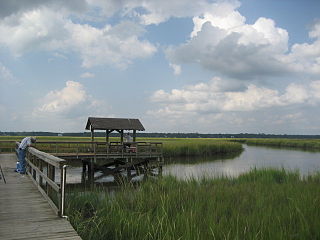
James Island is a town in Charleston County, South Carolina, United States. It is located in the central and southern parts of James Island. James Island is included within the Charleston-North Charleston-Summerville metropolitan area and the Charleston-North Charleston Urbanized Area.

The Cathedral of Saint Joseph of Wheeling or Saint Joseph's Cathedral is the seat of the bishop of the Catholic Diocese of Wheeling-Charleston. In addition to being the seat of the bishop, the cathedral is home to the oldest congregation in the city of Wheeling, West Virginia. The cathedral is a contributing property to the East Wheeling Historic District on the National Register of Historic Places.

St. Mary of the Annunciation Catholic Church is a Catholic church in Charleston, South Carolina, and was the first Catholic parish established in the Carolinas and Georgia. The current building at 93 Hasell Street and is the third structure to house the congregation on this site.

Government Street Presbyterian Church in Mobile, Alabama is one of the oldest and least-altered Greek Revival church buildings in the United States. The architectural design is by James Gallier Sr., James H. Dakin, and Charles Dakin. The trio also designed Barton Academy, four blocks down Government Street to the west. Government Street Presbyterian reflects the influences of Ithiel Town, Minard Lafever, and Andrew Jackson Downing. It was declared a National Historic Landmark in 1992.

The Woodward Avenue Presbyterian Church is a church located at 8501 Woodward Avenue in Detroit, Michigan. Built in 1911 in the Gothic Revival style, the architect was Sidney Badgley. It was used for some time as the Abyssinia Church of God in Christ. The building was listed on the National Register of Historic Places in 1982.

Fifth Avenue Presbyterian Church is a Presbyterian Church (U.S.A.) church in New York City. The church, on Fifth Avenue at 7 West 55th Street in Midtown Manhattan, has approximately 2,200 members and is one of the larger PCUSA congregations. The church, founded in 1808 as the Cedar Street Presbyterian Church, has been at this site since 1875.
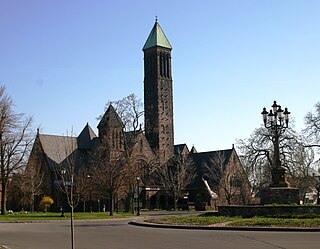
The First Presbyterian Church in Buffalo, New York was the first organized religious body formed in what was then the western frontier of New York State. The town of Buffalo was sparsely populated when the church was organized on February 2, 1812. However, having survived the War of 1812, the town of Buffalo was rebuilt and rapidly grew with the completion of the Erie Canal in 1825. The first two buildings were located on the same downtown lot. However, the congregation relocated between 1889 and 1891 to its present location approximately one and-a-half miles to the north in a more residential area.

The First Presbyterian Church in Batavia, New York, United States, is located at East Main and Liberty streets. It is a joined complex of several buildings. The main one, the church's sanctuary, is a limestone Gothic Revival structure built in the mid-19th century. Its congregation was the first church to be organized in Batavia, albeit as a Congregationalist group at that time.
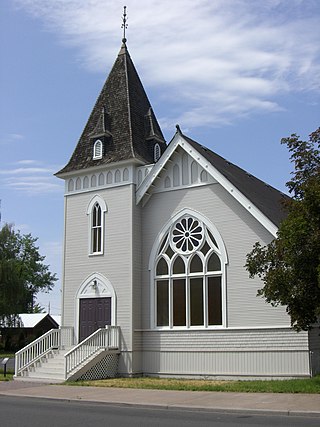
Built in 1912, the First Presbyterian Church of Redmond is the oldest standing church structure in the city of Redmond, Oregon, United States. It is also the second-oldest religious building in Deschutes County. The church was built in the Gothic Revival style with Queen Anne architectural detailing. It was the home of Protestant congregations from 1912 until 1979. Today, the building is privately owned and used as a special events venue. The First Presbyterian Church of Redmond was listed on the National Register of Historic Places in 2001.
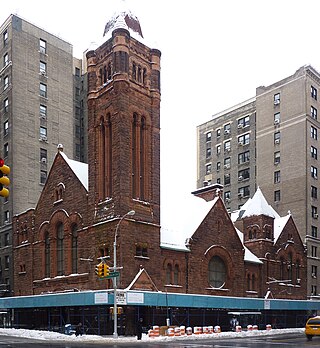
West-Park Presbyterian Church is a Romanesque Revival Presbyterian church located on the corner of Amsterdam Avenue at 86th Street on the Upper West Side of Manhattan in New York City. It consists of a main sanctuary and chapel.
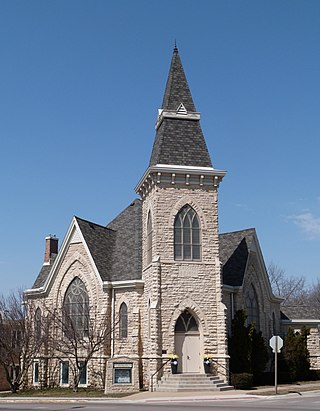
First Presbyterian Church is located in Marion, Iowa, United States. It was listed on the National Register of Historic Places in 1992.

The former Mizpah Presbyterian Church is a building in southeast Portland, Oregon.
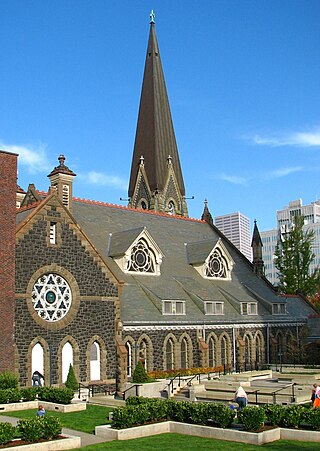
The First Presbyterian Church is a church building located in downtown Portland, Oregon, that is listed on the National Register of Historic Places. Construction began in 1886 and was completed in 1890. The building has been called "one of the finest examples" of High Victorian Gothic architecture in the state of Oregon. It includes stained-glass windows made by Portland's Povey Brothers Art Glass Works and a church bell cast with bronze from captured Civil War cannons.
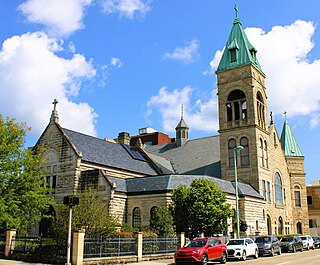
The Basilica of the Co-Cathedral of the Sacred Heart is a cathedral church and a minor basilica located in Charleston, West Virginia, United States. Along with the Cathedral of St. Joseph in Wheeling it is the seat of the Catholic Diocese of Wheeling-Charleston. The parish complex is a contributing property in the Downtown Charleston Historic District on the National Register of Historic Places.

The First Presbyterian Church is a historic church at 6505 Church Street in Cass City, Michigan. It was built in 1907 and added to the National Register in 2006.

First Presbyterian Church of New Orleans is the oldest Presbyterian congregation in Louisiana (1818) and the second oldest Protestant congregation in the entire Mississippi Basin after Christ Church of New Orleans (1816). First Presbyterian Church of New Orleans (FPCNO) has played a pivotal role in the history of the Protestant church in the South as well as the history of New Orleans in the late 19th century, especially under the political and religious leadership of Rev. Dr. Benjamin Morgan Palmer who encouraged the Southern Presbyterian Church to secede at the beginning of the American Civil War, an action which was quickly imitated by most of the other Protestant denominations in the Confederate States of America. However, in the 21st century, FPCNO is now more widely known for its progressive stands on race, social justice and gender issues.
Joseph Halsted McGee Jr. is an American former politician in the state of South Carolina. He served in the South Carolina House of Representatives from 1963 to 1968, representing Charleston County, South Carolina. He is a lawyer and judge. McGee helped shape Charleston's Four Corners of Law. His son-in-law is comedian Stephen Colbert.
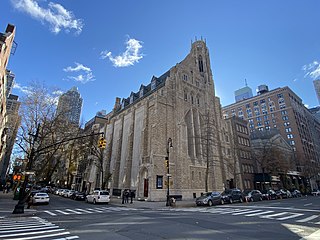
Central Presbyterian Church is a historic congregation on the Upper East Side of Manhattan in New York City, founded by pastor and abolitionist William Patton in 1821. It is a member of the Evangelical Presbyterian Church, and it worships in a Gothic Revival structure completed in 1922 that was originally commissioned and largely funded by John D. Rockefeller Jr. as Park Avenue Baptist Church.